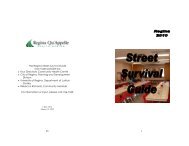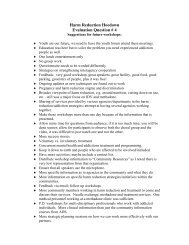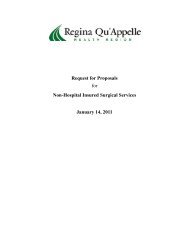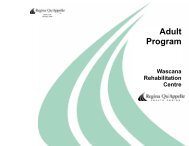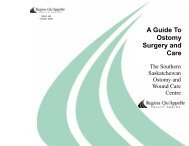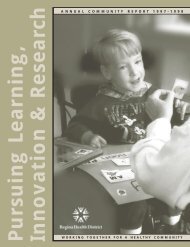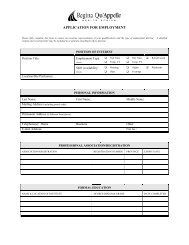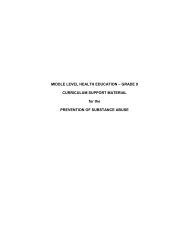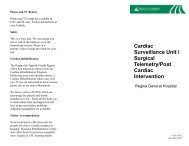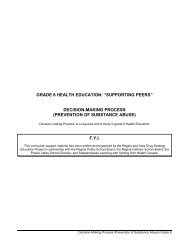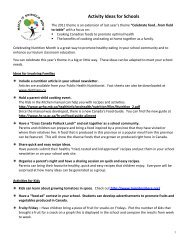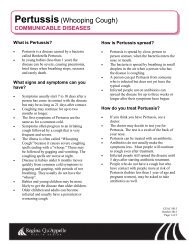Hand, Foot, and Mouth Disease (Vesicular Stomatitis)
Hand, Foot, and Mouth Disease (Vesicular Stomatitis)
Hand, Foot, and Mouth Disease (Vesicular Stomatitis)
Create successful ePaper yourself
Turn your PDF publications into a flip-book with our unique Google optimized e-Paper software.
<strong>H<strong>and</strong></strong>, <strong>Foot</strong>, <strong>and</strong> <strong>Mouth</strong> <strong>Disease</strong> (<strong>Vesicular</strong> <strong>Stomatitis</strong>)<br />
COMMUNICABLE DISEASES<br />
What is <strong>H<strong>and</strong></strong>, <strong>Foot</strong>, <strong>and</strong> <strong>Mouth</strong><br />
<strong>Disease</strong>?<br />
<br />
<br />
<br />
<strong>H<strong>and</strong></strong>, <strong>Foot</strong> <strong>and</strong> <strong>Mouth</strong> <strong>Disease</strong> is a common<br />
illness caused by a virus called Coxsackie<br />
Group A.<br />
It is found mostly in children under 10 but<br />
adult cases can occur.<br />
It is more common in summer <strong>and</strong> fall.<br />
What signs <strong>and</strong> symptoms can you<br />
have?<br />
How does a person get <strong>H<strong>and</strong></strong>, <strong>Foot</strong>,<br />
<strong>and</strong> <strong>Mouth</strong> <strong>Disease</strong>?<br />
<br />
<br />
<br />
It is spread from person-to-person by contact<br />
with fluids from the mouth <strong>and</strong> nose.<br />
The stool of an infected person contains the<br />
virus for several weeks after symptoms have<br />
disappeared.<br />
The virus can be passed from the fluid in the<br />
blisters.<br />
How do you treat <strong>H<strong>and</strong></strong>, <strong>Foot</strong>, <strong>and</strong><br />
<strong>Mouth</strong> <strong>Disease</strong>?<br />
<br />
<br />
<br />
<br />
Some people may have no symptoms.<br />
A person can get symptoms three to six days<br />
after being in contact with an infected person.<br />
Symptoms include:<br />
fever for 1-2 days<br />
a rash with small fluid filled blisters in<br />
the mouth, on the h<strong>and</strong>s, feet <strong>and</strong><br />
sometimes on the buttocks or groin<br />
small red spots on the palms of the h<strong>and</strong>s<br />
or soles of the feet. The spots may turn<br />
into small blisters<br />
blisters in the mouth may break <strong>and</strong><br />
appear as small ulcers on the tongue,<br />
gums <strong>and</strong> inside of cheeks.<br />
the rash can last for seven to ten days.<br />
Other common symptoms are headache, sore<br />
throat, loss of appetite <strong>and</strong> lack of energy.<br />
<br />
<br />
There is no specific treatment for this disease.<br />
Treat the fever with acetaminophen (Tylenol,<br />
Tempra).<br />
IMPORTANT - DO NOT USE ASA (Aspirin,<br />
acetylsalicylic acid) since it has been related to<br />
severe illness when given to children with viral<br />
infections.<br />
<br />
<br />
<br />
<br />
<br />
Children with a rash should see their doctor.<br />
Offer plenty of clear, cool fluids.<br />
A person with fever or diarrhea needs to be<br />
excluded from daycare or school.<br />
Children with the disease may return to the<br />
daycare or school if feeling well enough to<br />
participate in activities.<br />
During an outbreak, Public Health Services<br />
may recommend that children with open<br />
lesions on h<strong>and</strong>s or in the mouth be excluded<br />
from daycare.<br />
CEAC 3128<br />
December 2012<br />
Page 1 of 2
How can you Help Prevent <strong>H<strong>and</strong></strong>,<br />
<strong>Foot</strong>, <strong>and</strong> <strong>Mouth</strong> <strong>Disease</strong>?<br />
<br />
<br />
<br />
Good personal hygiene is the best protection<br />
against the spread of disease. This includes:<br />
washing h<strong>and</strong>s frequently<br />
keeping h<strong>and</strong>s away from nose <strong>and</strong> mouth<br />
not sharing personal items such as a<br />
toothbrush, towel, or water bottle.<br />
Always thoroughly wash h<strong>and</strong>s:<br />
after using the toilet<br />
after diapering a child<br />
before preparing or h<strong>and</strong>ling food<br />
before eating.<br />
Shared toys should be cleaned well with soap<br />
<strong>and</strong> water.<br />
For general information regarding a<br />
communicable disease contact a Public Health<br />
Nurse at (306) 766-7790 or call the Provincial<br />
Healthline at the toll-free number below.<br />
Page 2 of 2



